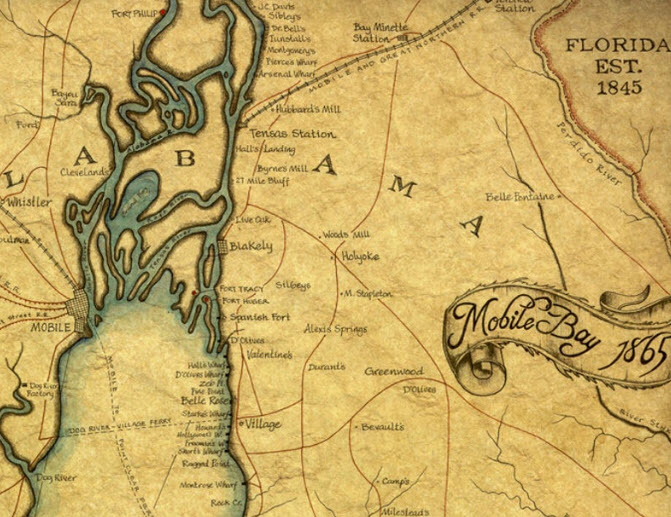The Village
Of “The Village” just above Daphne, Dr. H.H. Holmes says:
“As far back as history reaches we have stories of the Indians who roamed the woodlands of what is now Alabama and of their meetings just north of the Daphne of today. It was there that the Tensaws, the Alabamas, and later the Choctaws, the Creeks and the Seminoles, were to meet and plan, in their respective ages, the relationships of their tribes. It was there that the French in the days of Fort de la Mobile reconnoitered and planned for their overland trips to Fort Toulouse and other mountain fortresses from Quebec to the Gulf. …. It was there that the Spanish Cavaliers bivouacked, as they journeyed to Spanish Fort, only a few miles to the north. It was there that Andrew Jackson held his last council prior to marching upon Pensacola. It was there that a little city with homes of comfort, well laid out streets and lawns, where pioneer settlers dwelt, was built beside the sea a hundred years ago. It was there that Farragut’s men landed the troops to join and re-enforce those who marched overland to capture Spanish Fort and Blakeley just to the north. It was there that yellow fever, more than a hundred years ago, laid waste those happy homes. And it was there than an old city lies obliterated by the passing of the century.”
Brief History
Prehistory Prolific archeological finds date Native Americans here from the Gulf Formational Period to the Late Mississippi Period.
1702 Old Mobile established near st. Stephen's. French colonists were clustered on both sides of the bay in outposts where they had farms and cattle. One such outpost grew sizably by the second half of the century into The French Village - now known as Daphne.
1763 End of the French and Indian War. The British rule Mobile Bay and Ft. Louis is renamed Ft. Charlotte.
1766 There are about 17 plantations, 124 people and over 2,0OO head of cattle in and around The Village.
1770 Dominique D'Olive arrives in Mobile Bay from France.1780 Spain takes Mobile from the British.
1781 Bloody Revolutionary War battle at The Village* as Britain attacks a Spanish garrison but loses and retreats to Pensacola. *Some believe this battle was further north at Spanlsh Fort.
1787 Dominique D'Olive receives Spanish land grant for this property. He continues to live in Mobile but has an overseer to manage the farm and cattle on the Eastern Shore.
1803 U.S. acquires the LA Purchase. Dominique D'Olive dies at age 64 and is buried at the Cathedral in Mobile. His son Louis manages the family plantation and builds the La Belle Rose hotel on the bay but possibly does not move his family onto the plantation until near the time of the Creek Indian War.
1813 Ft. Mims Massacre and Creek Indian War bring danger to bay residents. The D'Olive plantation is attacked.
1814 Jackson's Oak -William Yancey (1799-1896) was born in Tennessee where he resided until 1810. He left with his father to travel to New Madrid, a Spanish post on the Mississippi River where both enlisted in the U.S. Army. From there, as a drummer boy, he proceeded to New Orleans later traveling to Mobile. When he was mustered out of service, he then settled in Baldwin County choosing the "vi!lage" for his home. It is his family's story that in 1814 General Andrew Jackson, with his soldiers left Mobile to capture Pensacola, crossing the bay on their way. At the "vlllace" they stopped for food under a large oak tree covered in moss. Today that same Oak is known as "Jackson's Oak." He then proceeded with his men to Pensacola where they captured Pensacola with little difficulty.
1819 Alabama becomes a state. From,1819 to 1834 Ft.Morgan is built. Louis D'Otive and his uncle Turner Starke make most of the bricks used to build Ft. Morgan and ship them from Starke's Wharf.
1820 Census shows 25 people living on the D'Olive plantation.
1836 Map shows only 5 structures at The Village.
1841 Louis D'Olive dies at age 68.
1865 Union troops march across D'Olive property near Scenic 98 after landing at Starke's Wharf then proceed to Blakely. Louis's sons J.L. and Mederick served in the Confederacy.
Contact Us
PO Box 1374 Daphne, AL 36526
contact@VillagePoint.info
Copyright 2019 Village Point Foundation
Website by PC
Professionals
Statistics
